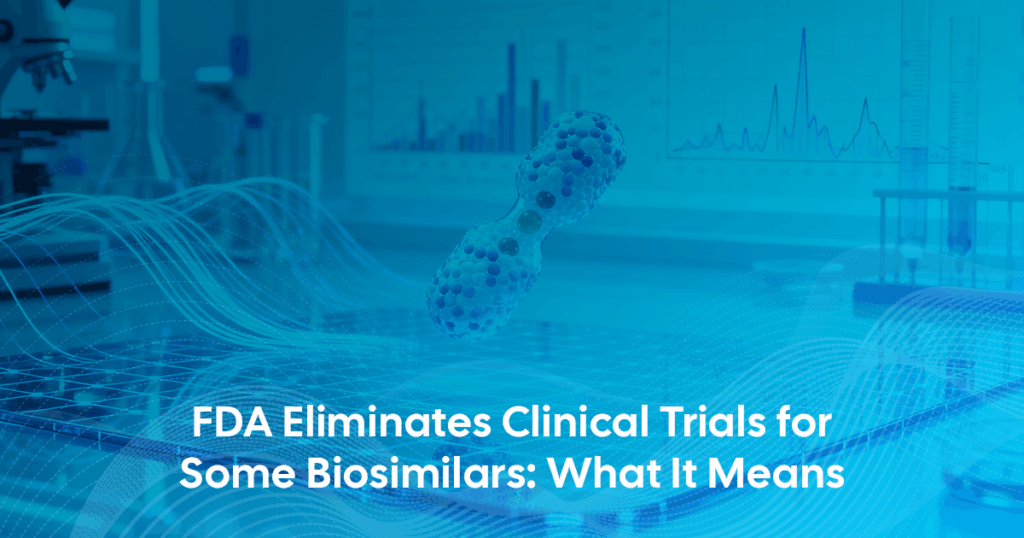If you think biosimilar strategy is ‘just’ generics-plus, think again, 2025 is the watershed year.
The U.S. FDA has signaled a strategic shift in biosimilar development requirements. On 29 October 2025, the agency released a draft guidance proposing that certain biosimilars may be approved without comparative clinical efficacy studies if advanced analytical comparability demonstrates a high degree of similarity to the reference biologic.
This development aligns with FDA’s position that new analytical technologies can detect clinically meaningful differences with greater sensitivity than legacy human efficacy trials.
The policy has strategic implications for global biosimilar development, but the opportunity for Indian manufacturers and sponsors using India as a development base is particularly significant.
What exactly has the FDA announced?
Key points from the draft guidance
The draft guidance titled “Scientific Considerations in Demonstrating Biosimilarity to a Reference Product: Updated Recommendations for Assessing the Need for Comparative Efficacy Studies” proposes the following:
- Many biosimilars will no longer require comparative clinical efficacy studies if structural, functional, and quality analytical data are robust.
- The agency acknowledges that analytical tools now provide higher precision in detecting differences than clinical trials.
- The FDA also indicated that switching studies for interchangeable biosimilars may be unnecessary in many cases.
The draft policy is aligned with FDA’s broader affordability agenda, given that biologics represent 5% of prescriptions but ~51% of U.S. drug spending.
What does not change
- PK/PD studies and immunogenicity assessments will remain necessary.
- Sponsors must demonstrate analytical similarity before, not after, requesting trial waivers.
- The draft is open for public comment and may evolve further before implementation.
Why This Shift Matters for the Global Market
Cost and Timeline Reduction
Clinical efficacy trials have historically represented one of the most time- and cost-intensive components of biosimilar development. Removing these requirements for qualifying molecules compresses launch timelines and rebalances commercial feasibility models.
Acceleration of Competitive Pressure
A streamlined pathway may result in:
- Earlier market entry
- Broader market competition
- Faster price normalization
- Increased payer and formulary adoption
Biologics facing patent expiry in oncology, immunology, ophthalmology, and rare disease categories will be affected first.
Strategic Shift Toward Analytical Excellence
The criteria for differentiation no longer sit in clinical outcomes. They now rest in:
- Structural similarity evidence
- Functionality comparability
- Process reproducibility
- CMC robustness
- Data transparency
A biosimilar manufacturer’s analytical ecosystem becomes its competitive identity.
How Manufacturers and Sponsors Should Adapt
- Regulatory Strategy Redesign
Regulatory submissions must be reframed to justify why a biosimilar does not require a confirmatory clinical trial. This requires:
- Early regulatory consultation
- Evidence-based justification frameworks
- Molecule-specific risk assessments
- Scientific narrative alignment with FDA guidance language
Strong regulatory writing becomes critical.
- Dossier and Submission Evolution
Module 3 now carries renewed weight. Sponsors must expand:
- Analytical characterization reports
- CQA justification models
- Platform comparability evidence
- PK/PD modeling data
- Immunogenicity rationale documentation
The dossier becomes proof of scientific certainty rather than proof of clinical replication.
- Manufacturing and CMC Preparedness
The FDA shift intensifies scrutiny on:
- Process consistency
- Cell banking integrity
- Process validation
- Raw material traceability
- comparability post-scale or site change
CMC maturity becomes the surrogate for trial data.
- Role of Pharmacovigilance and Real-World Evidence
With reduced premarket exposure, post-market surveillance becomes strategically significant. Developers should enhance:
- Real-world evidence capture strategies
- Risk management plans
- Immunogenicity signal detection systems
- Data integration frameworks for regulators and payers
How Other Regulatory Agencies May Respond
Region | Expected Direction |
EMA | Likely cautionary adaptation with condition-based trial elimination |
MHRA (UK) | Positioned to align with evidence-based flexibility |
Health Canada | May adopt selective trial waivers |
PMDA Japan | Historically conservative; slower shift expected |
WHO PQ | May explore alignment as affordability demand rises |
Global convergence will not be instant, but regulatory philosophy has begun to shift.
Stakeholder Implications
Stakeholder Group | Impact |
Regulators | Move toward science-based flexibility and RWE integration |
Manufacturers | Investment shifts from clinical operations to analytics and CMC |
Payers | A more competitive biosimilar environment with pricing leverage |
Healthcare systems | Faster access pathways and expanded treatment affordability |
What Comes Next
The core questions now shaping industry debate include:
- Will interchangeability lose strategic relevance?
- Will clinical trials become limited to only first-in-class biosimilar categories?
- Will real-world evidence replace confirmatory trials?
- Will regulatory frameworks converge internationally?
Biosimilar development is entering a new phase where technical sophistication replaces trial volume.
Conclusion
The FDA’s 2025 draft guidance marks a structural change in biosimilar development. Clinical efficacy studies are no longer the default barrier. Analytical science, CMC maturity, and risk-based justification now define readiness.
Manufacturers that strengthen analytical platforms, regulatory justification capability, manufacturing precision, and post-market evidence systems will be positioned to lead in the next era of biosimilar competition.
Read more from DDReg: Rethinking Benefit-Risk Assessment in a World of Precision Medicine

